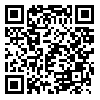
Journal of Modern Research Physics

Volume 8, Issue 1 (Spring and Summer 2023 2023)
JMRPh 2023, 8(1): 15-23 |
Back to browse issues page
Download citation:
BibTeX | RIS | EndNote | Medlars | ProCite | Reference Manager | RefWorks
Send citation to:



BibTeX | RIS | EndNote | Medlars | ProCite | Reference Manager | RefWorks
Send citation to:
Salehpour S. Investigating the application of a structure with perovskite active layer and aluminum metal contact as a memristor. JMRPh 2023; 8 (1) :15-23
URL: http://jmrph.khu.ac.ir/article-1-233-en.html
URL: http://jmrph.khu.ac.ir/article-1-233-en.html
Physics Department, Faculty of Basic Sciences, University of Mazandaran, Babolsar, Iran
Abstract: (230 Views)
In the present research, we addressed the movement of ionic carriers inside perovskite, which was used as an active layer in the structure. These carriers can lead to the creation of hysteresis in the cyclic voltammetry diagram of the device. Other layers of the device, including the metal contacts, can also play a role in the currents. To investigate this issue, we investigated the role of aluminum metal contact. In addition, we placed a Spiro-OMeTAD layer between the metal contact and the perovskite and investigated its role in the device's behavior. According to the results of the cyclic voltammetry analysis, a peak was observed in the absence of radiation in the diagrams, which can be attributed to the occurrence of a Redox reaction in the structure. Because the ions are mobile in the structure, as a result of this movement, the iodine ions move towards the metal contact of aluminum and react with aluminum to form aluminum iodide. This type of behavior (related to the peak of Redox reaction) in this device is called capacitive behavior, which is not desirable for memristor devices. There is a type of behavior called inductive behavior, which is desirable for memristors and was not observed in the fabricated devices.
Type of Study: Research |
Subject:
Special
Received: 2024/02/15 | Accepted: 2024/12/2 | Published: 2023/09/1 | ePublished: 2023/09/1
Received: 2024/02/15 | Accepted: 2024/12/2 | Published: 2023/09/1 | ePublished: 2023/09/1
Send email to the article author
| Rights and permissions | |
 |
This work is licensed under a Creative Commons Attribution-NonCommercial 4.0 International License. |


